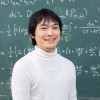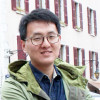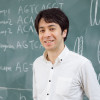Seminar
751 events
-
Seminar
Conserved charges in gravity and entropy
December 10 (Thu) at 13:00 - 14:30, 2020
Sinya Aoki (Professor, Yukawa Institute for Theoretical Physics, Kyoto University)
We propose a manifestly covariant definition of a conserved charge in gravity. We first define a charge density from the energy momentum tensor with a Killing vector, if exists in the system, and calculate the energy (and angular momentum) of the black hole by a volume integral. Our definition of energy leads to a correction of the known mass formula of a compact star, which includes the gravitational interaction energy and is shown to be 68\% of the leading term in some case. Secondly we propose a new method to define a conserved charge in the absence of Killing vectors, and argue that the conserved charge can be regarded as entropy, by showing the 1st law of thermodynamic for a special case. We apply this new definition to the expanding universe, gravitational plane waves and the black hole. We discuss future directions of our research.
Venue: via Zoom
Event Official Language: English
-
Seminar

How to obtain the large amount of sequence data from the eukaryote
December 10 (Thu) at 10:00 - 11:00, 2020
Euki Yazaki (Postdoctoral Researcher, RIKEN Interdisciplinary Theoretical and Mathematical Sciences Program (iTHEMS))
Most of the modern biology is supported by genetic sequence data. Recent advances in sequencing technology have made it possible to obtain comprehensive and large numbers of sequence data from a small amount of samples, which are deposited in public databases and are easily available. In this talk, I want to give an overview of how these large scale sequence data are obtained from samples and how they become available for us to use in our biological studies, through my eukaryotic sequence studies.
Venue: via Zoom
Event Official Language: English
-
Seminar

Journal Club of Information Theory SG II
December 8 (Tue) at 13:00 - 14:00, 2020
Akinori Tanaka (Senior Research Scientist, RIKEN Interdisciplinary Theoretical and Mathematical Sciences Program (iTHEMS))
The practical updating process of deep neural networks based on stochastic gradient descent is quite similar to stochastic dynamics described by Langevin equation. Under the Langevin system, we can "derive" 2nd law of thermodynamics, i.e. increasing the total entropy of the system. This fact suggests "2nd law of thermodynamics in deep learning." In this talk, I would like to explain this idea roughly, and there will be no concrete new result, but it may provide us new perspectives to study neural networks, I hope.
Venue: via Zoom
Event Official Language: English
-
Seminar
Scattering theory for half-line Schrödinger operators: analytic and topological results
December 7 (Mon) at 16:00 - 18:10, 2020
Hideki Inoue (Nagoya University)
Levinson’s theorem is a surprising result in quantum scattering theory, which relates the number of bound states and the scattering part of the underlying quantum system. For the last about ten years, it has been proved for several models that once recast in an operator algebraic framework this relation can be understood as an index theorem for the Møller wave operators. Resulting index theorems are called topological version of Levinson’s theorem or shortly topological Levinson’s theorem. In this talk, we first review the background and the framework of our investigation. New analytical and topological results are provided for Schrödinger operators on the half-line. This talk is based on my Ph.D thesis.
Venue: via Zoom
Event Official Language: English
-
Seminar
KPZ equation, attractive bosons, and the Efimov effect
December 3 (Thu) at 13:00 - 14:30, 2020
Yusuke Nishida (Associate Professor, Department of Physics, Tokyo Institute of Technology)
The Kardar-Parisi-Zhang (KPZ) equation for surface growth has been a paradigmatic model in nonequilibrium statistical physics. In particular, it in dimensions higher than two undergoes a roughening transition from smooth to rough phases with increasing the nonlinearity. It is also known that the KPZ equation can be mapped onto quantum mechanics of attractive bosons with a contact interaction, where the roughening transition corresponds to a binding transition of two bosons with increasing the attraction. Such critical bosons in three dimensions actually exhibit the Efimov effect, where a three-boson coupling turns out to be relevant under the renormalization group so as to break the scale invariance down to discrete one. On the basis of these facts linking the two distinct subjects in physics, we predict that the KPZ roughening transition in three dimensions shows either the discrete scale invariance or no intrinsic scale invariance.
Venue: via Zoom
Event Official Language: English
-
Seminar
Directional dark matter search and the technologies
December 3 (Thu) at 10:00 - 11:00, 2020
Tatsuhiro Naka (Lecturer, Department of Physics, Toho University / Specially Appointed Assistant Professor, Kobayashi-Maskawa Institute for the Origin of Particles and the Universe (KMI), Nagoya University)
For identification of the dark matter, various methodologies are required. Especially, the direct detection is one of the most important goals to directly understand itself. Now, there are various technologies for direct detection, but almost all detectors have no direction sensitivity. We can obtain essential information such as dependence of motion between the earth and the dark matter, velocity distribution and background from direction information, therefore that becomes a very important methodology to identify the dark matter for future as long as we consider "particle dark matter". In this seminar, I report about the potential of direction sensitive dark matter search and current experimental effort.
Venue: via Zoom
Event Official Language: English
-
Seminar

Journal Club of Information Theory SG
December 1 (Tue) at 13:00 - 14:00, 2020
Akinori Tanaka (Senior Research Scientist, RIKEN Interdisciplinary Theoretical and Mathematical Sciences Program (iTHEMS))
The practical updating process of deep neural networks based on stochastic gradient descent is quite similar to stochastic dynamics described by Langevin equation. Under the Langevin system, we can "derive" 2nd law of thermodynamics, i.e. increasing the total entropy of the system. This fact suggests "2nd law of thermodynamics in deep learning." In this talk, I would like to explain this idea roughly, and there will be no concrete new result, but it may provide us new perspectives to study neural networks, I hope. *Detailed information about the seminar refer to the email.
Venue: via Zoom
Event Official Language: English
-
Seminar

Flat and spherical surface approximations
November 30 (Mon) at 16:00 - 17:30, 2020
Martin Skrodzki (Visiting Scientist, RIKEN Interdisciplinary Theoretical and Mathematical Sciences Program (iTHEMS) / Fellow, German Academic Scholarship Foundation, Germany)
State-of-the-art acquisition devices produce surface representations of increasingly high resolution. While these detailed representations are important for production, they are problematic e.g. when exchanging drafts via the internet or when a quick rendering for comparison is necessary. In the first part of the talk, I will present results and further research questions from a paper I recently co-authored on 'Variational Shape Approximation'. This approach aims at linearizing the input surface and representing it via a set of localized planar segments. In the second part of the talk, I will present some ongoing research on surface representations via balls. This work started with constructions from spherical neodym magnets and provided a set of mathematical questions. These investigations are joint work with FU Berlin and OIST.
Venue: via Zoom
Event Official Language: English
-
Seminar
Rotifer can be a good model organism for theoretical biology
November 27 (Fri) at 10:00 - 11:00, 2020
Yuri Kominami (Specially Appointed Assistant Professor, Graduate School of Agricultural and Life Sciences, The University of Tokyo)
Rotifers are cylindrical zooplankton which constitute the phylum Rotifera. They have organs and tissues including ganglia, muscles, digestive organs, ovaries, and sensory organs in their <1mm body. Rotifers are suitable for the study on the population dynamics and longevity due to their short generation time. Furthermore the most attractive characteristic of the rotifers is asexual propagation, makes it easy to obtain clonal cultures. The genomic and transcriptomic database are developed and molecular biological techniques such as RNAi for using rotifers have been established. In this seminar, other attractive characteristics of rotifer as a model organism for theoretical biology and great studies using rotifers will be introduced. Our recent results of investigating the effects of calorie condition on longevity will be discussed.
Venue: via Zoom
Event Official Language: English
-
Seminar
Symmetry and conservation laws in neural networks
November 20 (Fri) at 10:00 - 11:00, 2020
Hidenori Tanaka (Group Leader & Senior Scientist, Physics & Informatics Laboratories, NTT Research, Inc., USA / Visiting Scholar, Stanford University, USA)
Symmetry is the central guiding principle in the exploration of the physical world but has been underutilized in understanding and engineering neural networks. We first identify simple yet powerful geometrical properties imposed by symmetry. Then, we apply the theory to answer a series of following important questions: (i) What, if anything, can we quantitatively predict about the complex learning dynamics of real-world deep learning models driven by real-world datasets? (ii) How can we make deep learning models more efficient by removing parameters without disconnecting information flow? (iii) How can we distill experimentally testable neuroscientific hypotheses by reducing the complexity of deep learning models mimicking the brain? Overall, our approach demonstrates how we can harness the principles of symmetry and conservation laws to reduce deep learning models' complexity and make advances in the science and engineering of biological and artificial neural networks.
Venue: via Zoom
Event Official Language: English
-
Seminar
Representations of fundamental groups and 3-manifold topology
November 16 (Mon) at 16:00 - 18:10, 2020
Takahiro Kitayama (Associate Professor, Graduate School of Mathematical Sciences, The University of Tokyo)
In 3-dimensional topology the great progress during the last two decades revealed that various properties of 3-manifolds are well understood from their fundamental groups. I will give an introduction to the study of splittings of 3-manifolds along surfaces, with an emphasis on an application of group representations. A fundamental and difficult problem in general is to find surfaces essentially embedded in a given 3-manifold. I will explain how such surfaces are detected by deformations of representations of the fundamental group, and what information of detected surfaces is described in terms of topological invariants derived from representations.
Venue: via Zoom
Event Official Language: English
-
Seminar

Efficient probabilistic assessment of building performance: sequential Monte Carlo and decomposition methods
November 13 (Fri) at 16:00 - 18:10, 2020
Tianfeng Hou (Postdoctoral Researcher, RIKEN Interdisciplinary Theoretical and Mathematical Sciences Program (iTHEMS) / Postdoctoral Researcher, Prediction Science Laboratory, RIKEN Cluster for Pioneering Research (CPR) / Postdoctoral Researcher, Data Assimilation Research Team, RIKEN Center for Computational Science (R-CCS))
The use of numerical simulations for complex systems is common. However, significant uncertainties may exist for many of the involved variables, and in order to ensure the reliability of our simulation results and the safety of such complex systems, a stochastic approach providing statistics of the probability distribution of the results is of crucial importance. However, when a highly accurate result is required, the conventional Monte Carlo based probabilistic methodology inherently requires many repetitions of the deterministic analysis and in cases where that deterministic simulation is (relatively) time consuming, such probabilistic assessment can easily become computationally intractable. Hence, to reduce the computational expense of such probabilistic assessments as much as possible, the targets of this seminar are twofold: (1), to exploit an efficient sampling strategy to minimize the number of needed simulations of Monte Carlo based probabilistic analysis; (2), to investigate a surrogate model to reduce the computational expense of single deterministic simulation. This seminar contains two parts and will be accompanied by a set of illustrative building physical case studies (analysis of the heat and moisture transfer through building components). The first part of this seminar focusses on the use of quasi-Monte Carlo based probabilistic assessment for building performance, since it has the potential to outperform the standard Monte Carlo method. More specifically, the quasi-Monte Carlo sampling strategies and related error estimation techniques will be introduced in detail. In addition, questions on under which conditions the quasi-Monte Carlo can outperform the standard Monte Carlo method will be answered by a set of analyses. The second part of this seminar targets the investigation of using model order reduction methods for optimizing the deterministic simulation, given that it generally allows a (large) reduction of the simulation time without losing the dynamic behavior of the conventional models (such as the transient finite element analysis). Particularly, the fundamental concepts of one common model order reduction method – proper orthogonal decomposition (POD) will be provided, and its potential use for simulating (building physical) problems with different levels of non-linearity and complexity will be illustrated.
Venue: via Zoom
Event Official Language: English
-
Seminar
Some idea on quantum tunneling via Lefschetz thimbles
November 12 (Thu) at 10:30 - 12:00, 2020
Yuya Tanizaki (Special Postdoctoral Researcher, Theory Group, RIKEN Nishina Center for Accelerator-Based Science (RNC) / Assistant Professor, Yukawa Institute for Theoretical Physics, Kyoto University)
In this talk, I will explain my previous study with Takayuki Koike on a possible approach to quantum tunneling via Lefschetz thimbles. We classified all the complex saddle points for the real-time path integral for the symmetric double-well quantum mechanics. We looked at various properties of those complex solutions, which motivated us to conclude that the computation of tunneling amplitudes for the symmetric double well requires the interference of infinitely many Lefschetz thimbles. I would also like to talk about some speculations, admittingly being very optimistic.
Venue: via Zoom
Event Official Language: English
-
Seminar
Mathematics of thermalization in isolated quantum systems
November 10 (Tue) at 16:00 - 18:10, 2020
Naoto Shiraishi (Assistant Professor, Department of Physics, Faculty of Science, Gakushuin University)
If an isolated macroscopic quantum system is left at a nonequilibrium state, then this system will relax to the unique equilibrium state, which is called thermalization. Most of quantum many-body systems thermalize, while some many-body systems including integrable systems do not thermalize. What determines the presence/absence of thermalization and how to understand thermalization from microscopic quantum mechanics are profound long-standing problems. In the first part of my talk, I briefly review some established results of quantum thermalization. I first clarify the problem of thermalization in a mathematical manner, and then introduce several important results and insights: typicality of equilibrium states [1], relaxation caused by large effective dimension [2], and eigenstate thermalization hypothesis (ETH) [3,4] and weak-ETH [5]. In the second part of my talk, I explain some of my results. First, I introduce a model which is non-integrable and thermalizes but does not satisfy the ETH [6,7]. This finding disproves the conjectures that all nonintegrable systems satisfy the ETH and that the ETH is a necessary condition for thermalization. I also discuss the hardness of the problem of thermalization from the viewpoint of computational science [8]. Then, I move to an analytical approach to a concrete model, and prove that S=1/2 XYZ chain with a magnetic field is nonintegrable [9]. This is the first example of proof of nonintegrability in a concrete quantum many-body system, which will help a mathematical approach to thermalization.
Venue: via Zoom
Event Official Language: English
-
Seminar
Mathematical aspects of quasi-Monte Carlo integration
November 5 (Thu) at 16:00 - 18:10, 2020
Kosuke Suzuki (Assistant Professor, Graduate School of Advanced Science and Engineering, Hiroshima University)
In this talk, I will introduce mathematical aspects of quasi-Monte Carlo (QMC) integration. We aim to approximate the integral of a function on the d-dimensional hypercube [0,1]^d. A useful approach is Monte-Carlo (MC) integration, which uses randomly chosen samples. A drawback of MC is the rate of convergence; the standard deviation of the estimator converges as 1/sqrt(n) asymptotically in n. To have a better rate of convergence as O(log^d N/N) or more, QMC uses deterministic, uniformly distributed points. In the first part, I will give an overview of QMC, such as star-discrepancy, Koksma-Hlawka inequality, and some explicit constructions as lattices and digital nets. In the second part, I will show that QMC using lattices and digital nets can achieve a higher rate of convergence for smooth integrands.
Venue: via Zoom
Event Official Language: English
-
Seminar
Evolution of a peak of genetic divergence driven by local adaptation
November 5 (Thu) at 10:00 - 11:00, 2020
Takahiro Sakamoto (Postdoctoral Researcher, School of Advanced Sciences, The Graduate University for Advanced Studies (SOKENDAI))
In species that are distributed in various environments, each subpopulation adapts to the local environment. In general, when there is migration between subpopulations, genetic divergence does not proceed because the genomes are exchanged between subpopulations. However, around the loci involved in local adaptation, genetic divergence proceeds. This is because different genotypes are favored between subpopulations, so that the alleles of migrants are purged by natural selection and the exchange of genomes is suppressed. It has not been theoretically known how the degree of genetic differentiation evolves over time, making the interpretation of population genomic data difficult. In this study, we constructed and analyzed a model of population genetics to clarify the dynamics of genetic divergence.
Venue: via Zoom
Event Official Language: English
-
Seminar

Basics of population genomic data analysis
October 29 (Thu) at 10:00 - 11:00, 2020
Jeffrey Fawcett (Senior Research Scientist, RIKEN Interdisciplinary Theoretical and Mathematical Sciences Program (iTHEMS))
In recent years, it has become possible to obtain the DNA sequence data of a large number of individuals of the same species. This data set is basically a M (number of samples) x N (number of genomic positions) matrix where each data point is 0 or 1. Using this data set, we try to understand, for example, the relationship between each sample or group of samples, and the population process that has generated the data set. In this talk, I will introduce the basic concepts behind the approaches we use to analyze such data sets.
Venue: via Zoom
Event Official Language: English
-
Seminar
Toward simulating Superstring/M-theory on a Quantum Computer
October 23 (Fri) at 17:00 - 18:00, 2020
Masanori Hanada (Department of Mathematics, University of Surrey, UK)
We present a framework for simulating superstring/M-theory on a quantum computer, based on holographic duality. Because holographicduality maps superstring/M-theory to quantum field theories (QFTs), we can study superstring/M-theory if we can put such QFTs on a quantum computer --- but it still looks like a complicated problem, if we use a usual lattice regularization. Here we propose an alternative approach, which turns out to be rather simple: we map the QFT problems to matrix models, especially the supersymmetric matrix models such as the Berenstein-Maldacena-Nastase (BMN) matrix model. Supersymmetric matrix models have natural applications to superstring/M-theory and gravitational physics, in an appropriate limit of parameters. Furthermore, for certain states in the Berenstein-Maldacena-Nastase (BMN) matrix model, several supersymmetric quantum field theories dual to superstring/M-theory can be realized on a quantum device. It is straightforward to put the matrix models on a quantum computer, because they are just quantum mechanics of matrices, and the construction of QFTs is mapped to the preparation of certain states. We show the procedures are conceptually rather simple and efficient quantum algorithms can be applied. In addition, as a (kind of) byproduct, we provide a new formulation of pure Yang-Mills on quantum computer. If you would like to participate, please register using the form below.
Venue: via Zoom
Event Official Language: English
-
Seminar
Realistic shell model and chiral three-body force
October 22 (Thu) at 13:30 - 15:00, 2020
Tokuro Fukui (Researcher, Yukawa Institute for Theoretical Physics, Kyoto University)
We show an evolution to derive the effective Hamiltonian in the shell-model framework starting from two- and three-body interactions based on the chiral effective field theory. A new way to calculate three-body matrix elements of the chiral interaction with the nonlocal regulator is proposed. We apply our framework to the p-shell nuclei and perform benchmark calculations to compare our results with those by an ab initio no-core shell-model. We report that our results are satisfactory and the contribution of the three-body force is essential to explain experimental low-lying spectra of the p-shell nuclei. We discuss the contribution of the three-body force on the effective single-particle energy extracted from the monopole interaction. Next, we investigate the shell evolution on the pf-shell nuclei. We show that the monopole component of the shell-model effective Hamiltonian induced by the three-body force plays an essential role to account for the experimental shell evolution. Moreover, we present our latest results on the investigation of the possible neutron dripline of the Ca isotopes. Finally, we discuss very neutron-rich systems, namely, the oxygen isotopes at the dripline and beyond, where the interplay between the three-body force and continuum states plays an important role. If you would like to participate, please register using the form below.
Venue: via Zoom
Event Official Language: English
-
Seminar
Bayesian nonparametric estimation of Random Dynamical Systems
October 21 (Wed) at 14:00 - 15:00, 2020
Christos Merkatas (Postdoctoral Researcher, Aalto University, Finland)
In this talk, a Bayesian nonparametric framework for the estimation and prediction, from observed time series data, of discretized random dynamical systems is presented [1]. The size of the observed time series can be small and the additive noise may not be Gaussian distributed. We show that as the dynamical noise departs from normality, simple Markov Chain Monte Carlo method (MCMC) models are inefficient. The proposed models assume an unknown error process in the form of a countable mixture of zero mean normals, where a–priori the number of the countable normal components and their variances is unknown. Our method infers the number of unknown components and their variances, i.e., infers the density of the error process directly from the observed data. An extension for the joint estimation and prediction of multiple discrete time random dynamical systems based on multiple time-series observations contaminated by additive dynamical noise is presented [2]. In this case the model assumes an unknown joint error process with a pairwise dependence in the sense that to each pair of unknown dynamical error processes, we assign a– priori an independent Geometric Stick-Breaking process mixture of normals with zero mean. These mixtures a–posteriori will capture common characteristics, if there are any, among the pairs of noise processes. We show numerically that when the unknown error processes share common characteristics, it is possible under suitable prior specification to induce a borrowing of strength relationship among the dynamical error pairs. Then time-series with an inadequate sample size for an independent Bayesian reconstruction can benefit in terms of model estimation accuracy. Finally, possible directions for future research will be discussed.
Venue: via Zoom
Event Official Language: English
751 events
Events
Categories
series
- iTHEMS Colloquium
- MACS Colloquium
- iTHEMS Seminar
- iTHEMS Math Seminar
- DMWG Seminar
- iTHEMS Biology Seminar
- iTHEMS Theoretical Physics Seminar
- Information Theory SG Seminar
- Quantum Matter Seminar
- ABBL-iTHEMS Joint Astro Seminar
- Math-Phys Seminar
- Quantum Gravity Gatherings
- RIKEN Quantum Seminar
- Quantum Computation SG Seminar
- Asymptotics in Astrophysics SG Seminar
- GW-EOS WG Seminar
- DEEP-IN Seminar
- NEW WG Seminar
- Lab-Theory Standing Talks
- QFT-core Seminar
- STAMP Seminar
- QuCoIn Seminar
- Number Theory Seminar
- Academic-Industrial Innovation Lecture
- Berkeley-iTHEMS Seminar
- iTHEMS-RNC Meson Science Lab. Joint Seminar
- RIKEN Quantum Lecture
- Theory of Operator Algebras
- iTHEMS Intensive Course-Evolution of Cooperation
- Introduction to Public-Key Cryptography
- Knot Theory
- iTHES Theoretical Science Colloquium
- SUURI-COOL Seminar
- iTHES Seminar
